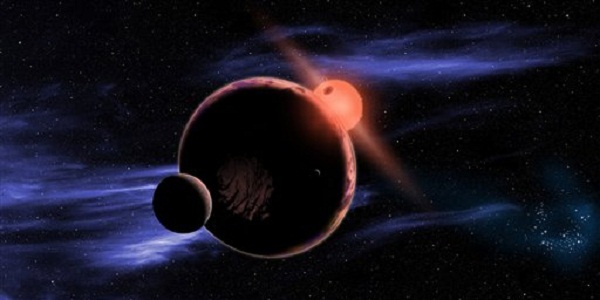Earth-like planets may be closer than thought—study

This artist’s conception provided by the Harvard-Smithsonian Center for Astrophysics shows a hypothetical planet with two moons orbiting in the habitable zone of a red dwarf star. Earth-like worlds may be closer and more plentiful than anyone imagined. Astronomers reported Wednesday, Feb. 6, 2013, that the closest Earth-like planet may be just 13 light years away. That planet hasn’t been found yet, but should be there based on the team’s study of red dwarf stars which are the most common stars in our galaxy. AP/HARVARD-SMITHSONIAN CENTER FOR ASTROPHYSICS, DAVID A. AGUILAR
WASHINGTON—Scientists looking for habitable planets may not have to stray far from our galactic neighborhood, said a new study Wednesday, which calculated an Earth-size planet could be orbiting a red dwarf as near as 13 light years away.
“We thought we would have to search vast distances to find an Earth-like planet. Now we realize another Earth is probably in our own backyard, waiting to be spotted,” said Harvard astronomer and lead author Courtney Dressing.
The researchers based their calculations on planets already discovered by the US super-telescope Kepler, focusing on the question of which “red dwarf” stars could have potentially habitable Earth-size planets in their orbits.
Red dwarfs are smaller, cooler and fainter than our solar system’s sun—and they are also the most commonly found stars in our galaxy, making up about three of every four stars in the Milky Way.
Kepler casts its gaze on around 158,000 stars and, based on the analysis by Dressing and her team, the telescope has identified 95 planetary candidates orbiting red dwarf stars.
Article continues after this advertisementBut most of those planets weren’t quite the right size or temperature to support life, so the researchers narrowed the candidates to just three that were both warm and approximately Earth-sized.
Article continues after this advertisementProjecting outward based on the estimated 75 billion red dwarf stars in our galaxy, they arrived at the prediction that around six percent of red dwarfs should have an Earth-like planet, and the nearest one could be just 13 light years away.
“We now know the rate of occurrence of habitable planets around the most common stars in our galaxy,” said co-author David Charbonneau.
“That rate implies that it will be significantly easier to search for life beyond the solar system than we previously thought.”
A light year is equivalent to around 5.8 trillion miles (9.46 trillion kilometers), or the distance light can travel in a year.
So 13 light years away is hardly a quick jaunt.
But it’s a whole lot closer than the 300-600 light years between us and the planet candidates Kepler has spotted to date in the so-called “habitable zone” where liquid water is capable of existing and thus supporting life.
The characteristics of red dwarfs make it relatively easy to spot planets orbiting them from far away—a process that relies on identifying dim spots created when the planet passes in front of its star.
But the researchers said scientists may have to dedicate a small space-based telescope, or a large network of ground-based ones, to looking for a nearby planet, since the larger space telescopes are aimed at further stars.
Dressing also cautioned that an Earth-like planet orbiting a red dwarf would look quite different from the green-and-blue one we call home, but said the differences didn’t rule out the existance of life.
“You don’t need an Earth clone to have life,” Dressing said.